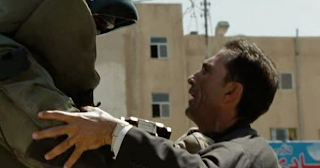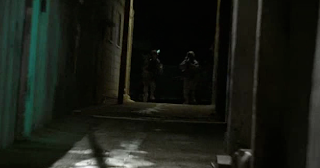

 1. Opening Remarks
1. Opening RemarksThe movie is about soldiers who is fighting in the Iraq war. The experiences of the soldiers made the film much more interesting and although the director chooses not to let the characters reveal their emotions through words, the audience sense and sees the struggle they are going through. In the beginning of the film, the quote that is used is the overarching theme of the movie. The last four words was still there (war is a drug) doesn't really make sense in the beginning as we see all the awful things the soldiers have to go through.
2. Context
The film is being shot at Jordon and only 3 miles away from Iraq to preserve the realism aspects. This is to keep the film's authenticity and what better way then "shooting in the Middle East". The director was concerned about the how authentic the film looked from the bombings to the locations no matter how difficult it is to pull it off, she pursued. The film also has a documentary feel to it to further realism. Kathryn Bigelow is a female director that is directing a film that is rather masculine. She wanted the movie to portray the modern hero instead of the "breaking of gender or genre traditions". She believes that her movie is different from other war movies because it is centered around a volunteer army. The time period also makes the subject a sensitive subject because Americans are all familiar with the war that is going on in Iraq. The thematic trends this film portrays is realism in a slightly documentary style.
3. Setting, Acting, Costume
The movie emphasize on the setting to create realism. The location is risky as we all know the Middle East is not a safe area. They used the location's natural elements to their advantage and incorporated that into the movie to create creditability. The costume, which includes the bomber uniform and the army uniform, are needed to also create realism even though the weather in the Middle East is not pleasant so it makes the costume much more harder to wear and keep on. The whole visual style the director is trying to portray is the war in Iraq and make it look as real as possible to keep the suspense and the story going. The director even uses refugees from the war to populate the setting. The main character, Sergeant William James, is acted by Jeremy Renner. He does a fantastic job with his image and look as well as his acting as the role of the Sergeant who is often times in dangerous situations. The believability of his acting contributed to the realism aspect of the film.
4. Cinematography and Lighting

The style of the movie is realistic. It is realistic because it is trying to portray the war in Iraq and let the audience see what is going on in Iraq everyday to understand it. The slight documentary style furthers the realistic elements of the movie with the hand-held work like zoom. It is formalistic because of the editing style in some areas like when they use complete coverage to cover one scene and the use of some music to create a mood at certain times. There is also some use of continuity editing because the scenes flows nicely since most of the scenes are relevant to each other. But there are also times where it lacks continuity editing because it just jumps to another scene without really knowing what happened to the end of the other scene like the scene when the soldiers are getting ambushed in the desert and the next scene they were in their base already. The angles, framing, and lens choice has variety in the film. In suspenseful moments, the framing get tighter and there are more angles they shoot from with an alternating lens choice. The camera and acting blocking also varies. The color used dominantly in this film is yellow because of the location in a desert area. The constant image of the gun, death, and blood relates back to the fact that they are at war. There is a lot of use of the long shot to give a general scope of their environment and the situation they are in. The time of the day usually determines the light. Since most of the time the soldiers are out, the use of natural light is dominant. At night though, there is more darkness therefore, more fast fall off.
5. Editing (picture shows parallel action and hurt locker respectively)


The editing style is documentary but also in a conventional way. The movie is shot in a rough documentary style but the editor wanted to bring out the "true, up-close-and-personal moments with the characters, emotions and storytelling" therefore, incorporating a more classical cutting style. The edit doesn't manipulate time since it follows a logical sequence. It skips moment in time and therefore, fast forwards to another point in the movie. The speed is sometimes manipulated to create dramatic effect like slow motion. The length of the cuts is relatively short and the pacing is therefore fast to create suspense. But during emotional parts, the shots are longer and the pacing is slower. There is use of parallel action to show tension usually between the three soldiers. The title of the movie, The Hurt Locker, is referred to the box that the soldier keeps under his bed of items. The items are things that caused him pain and suffering either mentally or physically.
6. Score
The music in this movie isn't dramatically noticeable so it's very subtle. The soundtrack music has eerie, synthetic/organic fusion scores. There was subtle background music that creates tension that was present only in suspenseful moments.
7. Script
The film is notable for its screenplay. It won Best Original Screenplay. The main characters, the soldiers, are enrolled voluntarily into the army and there is a countdown to the days of their enlistment ends. The storyline is driven by the character because of character motivation and their role in playing hero in the war. The main character wanted to play hero by diffusing bombs, and seeking revenge for whoever killed the little boy who he thought was dead. He went on this dangerous mission that is self-motivated to justify. He risks his life and the two other soldiers to his advantage for his desire to seek revenge as well as an adrenaline rush. There wasn't much dialogue in the movie as specific scenes like when they are getting ambushed in the desert because there was still tension and it actually adds tension too. There was a lot of swearing when they are at risk in the war either diffusing a bomb or getting attacked. The humor used is cynical and satire because of the bitter situation they are in but yet, they still enjoy it the same time. There was a lot of irony used. For example, when Sanborn asked the Sergeant if he could ever be the one diffusing the bombs yet he doesn't want to stay at Iraq anymore and wants to have a family. The soldiers archetype is hero, especially the Sergeant. He wants to be a war hero but ended up making a fool out of himself and dismissed the morals he believed in when he found out the little boy was still alive.
8. Genre
The genres of this movie is a war, documentary, action, and suspense. It is a war film because the whole film is revolved around war and in war with the soldiers in Iraq. It gives the audience a glimpse of what is happening at war therefore, it is a documentary too. The realism aspect as well as the shooting style of it being hand-held without classical conventions adds to the documentary style as well as the location and the events in the location is shown in the movie. The movie has action and suspense when they are in combat as well as suspense in the scenes where their lives are at risk. The action and suspense ties in with the war genre since a war movie has those elements in it. The part where those two differs is that war movies usually make the main character a hero of some sort and there is usually a defeated enemy. Action movies don't really have a hero in the end. The soldiers seem to have many missions of the same sort. They are just playing a small part in the large war so there isn't much contribution by them when compared to the larger scale of the war.
9. Closing Remarks
The ending of the main character reenlisting and going back to war ties back with the quote in the beginning where it says war is a drug. In his case, the quote is true since he finds the peaceful family life dull and in a way, pointless for him. He needs the adreneline and the thrill of being in the war and at risk. He likes fighting for his country and fighting for a purpose.



No comments:
Post a Comment